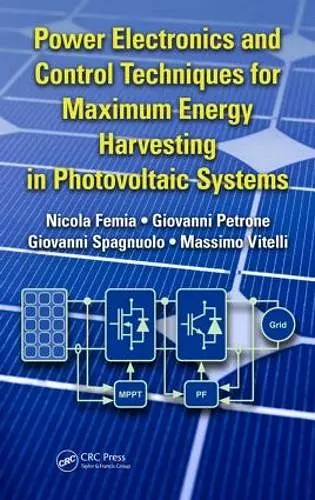Power Electronics and Control Techniques for Maximum Energy Harvesting in Photovoltaic Systems
Format:Hardback
Publisher:Taylor & Francis Inc
Published:18th Dec '12
Currently unavailable, and unfortunately no date known when it will be back

Incentives provided by European governments have resulted in the rapid growth of the photovoltaic (PV) market. Many PV modules are now commercially available, and there are a number of power electronic systems for processing the electrical power produced by PV systems, especially for grid-connected applications. Filling a gap in the literature, Power Electronics and Control Techniques for Maximum Energy Harvesting in Photovoltaic Systems brings together research on control circuits, systems, and techniques dedicated to the maximization of the electrical power produced by a photovoltaic (PV) source.
Tools to Help You Improve the Efficiency of Photovoltaic Systems
The book supplies an overview of recent improvements in connecting PV systems to the grid and highlights various solutions that can be used as a starting point for further research and development. It begins with a review of methods for modeling a PV array working in uniform and mismatched conditions. The book then discusses several ways to achieve the best maximum power point tracking (MPPT) performance. A chapter focuses on MPPT efficiency, examining the design of the parameters that affect algorithm performance. The authors also address the maximization of the energy harvested in mismatched conditions, in terms of both power architecture and control algorithms, and discuss the distributed MPPT approach. The final chapter details the design of DC/DC converters, which usually perform the MPPT function, with special emphasis on their energy efficiency.
Get Insights from the Experts on How to Effectively Implement MPPT
Written by well-known researchers in the field of photovoltaic systems, this book tackles state-of-the-art issues related to how to extract the maximum electrical power from photovoltaic arrays under any weather condition. Featuring a wealth of examples and illustrations, it offers practical guidance for researchers and industry professionals who want to implement MPPT in photovoltaic systems.
"… very innovative … provides a very rigorous analytical treatment starting from the modeling of the PV field and the power converter stages as well as the dynamics of the overall system, including MPPT control. This in-depth analytical description allows the design of power converters and DMPPT algorithms improving the overall efficiency of the whole PV system operating under mismatching conditions."
—Dr. Francesc Guinjoan, Polytechnic University of Catalonia, Barcelona, Spain
"… a concise but complete compendium of the required knowledge to understand, design, and control photovoltaic systems. … a good introduction to photovoltaic systems … also presents most of the recent advances on photovoltaic optimization … the authors are very well known in the scientific community, which provides confidence on the equations and conclusions given in the book."
—Carlos Andres Ramos Paja,Universidad Nacional de Colombia
"… very innovative … provides a very rigorous analytical treatment starting from the modeling of the PV field and the power converter stages as well as the dynamics of the overall system, including MPPT control. This in-depth analytical description allows the design of power converters and DMPPT algorithms improving the overall efficiency of the whole PV system operating under mismatching conditions."—Dr. Francesc Guinjoan, Polytechnic University of Catalonia, Barcelona, Spain
"… a concise but complete compendium of the required knowledge to understand, design, and control photovoltaic systems. … a good introduction to photovoltaic systems … also presents most of the recent advances on photovoltaic optimization … the authors are very well known in the scientific community, which provides confidence on the equations and conclusions given in the book."—Carlos Andres Ramos Paja, Universidad Nacional de Colombia
ISBN: 9781466506909
Dimensions: unknown
Weight: 635g
366 pages